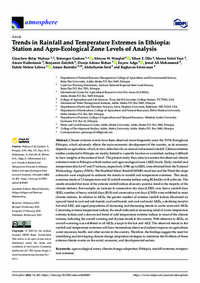Trends in Rainfall and Temperature Extremes in Ethiopia: Station and Agro-Ecological Zone Levels of Analysis

Authors:
Climate extreme events have been observed more frequently since the 1970s throughout Ethiopia, which adversely affects the socio-economic development of the country, as its economy depends on agriculture, which, in turn, relies heavily on annual and seasonal rainfall. Climate extremes studies conducted in Ethiopia are mainly limited to a specific location or watershed, making it difficult to have insights at the national level. The present study thus aims to examine the observed climate extreme events in Ethiopia at both station and agro-ecological zone (AEZ) levels. Daily rainfall and temperature data for 47 and 37 stations, respectively (1986 up to 2020), were obtained from the National Meteorology Agency (NMA). The Modified Mann–Kendall (MMK) trend test and the Theil–Sen slope estimator were employed to estimate the trends in rainfall and temperature extremes. This study examines trends of 13 temperature and 10 rainfall extreme indices using RClimDex in R software. The results revealed that most of the extreme rainfall indices showed a positive trend in the majority of the climate stations. For example, an increase in consecutive dry days (CDD), very heavy rainfall days (R20), number of heavy rainfall days (R10) and consecutive wet days (CWD) were exhibited in most climate stations. In relation to AEZs, the greater number of extreme rainfall indices illustrated an upward trend in cool and sub-humid, cool and humid, and cool and moist AEZs, a declining trend in hot arid AEZ, and equal proportions of increasing and decreasing trends in warm semi-arid AEZs. Concerning extreme temperature indices, the result indicated an increasing trend of warm temperature extreme indices and a downward trend of cold temperature extreme indices in most of the climate stations, indicating the overall warming and dryness trends in the country. With reference to AEZs, an overall warming was exhibited in all AEZs, except in the hot arid AEZ. The observed trends in the rainfall and temperature extremes will have tremendous direct and indirect impacts on agriculture, water resources, health, and other sectors in the country. Therefore, the findings suggest the need for identifying and developing climate change adaptation strategies to minimize the ill effects of these extreme climate events on the social, economic, and developmental sectors.
